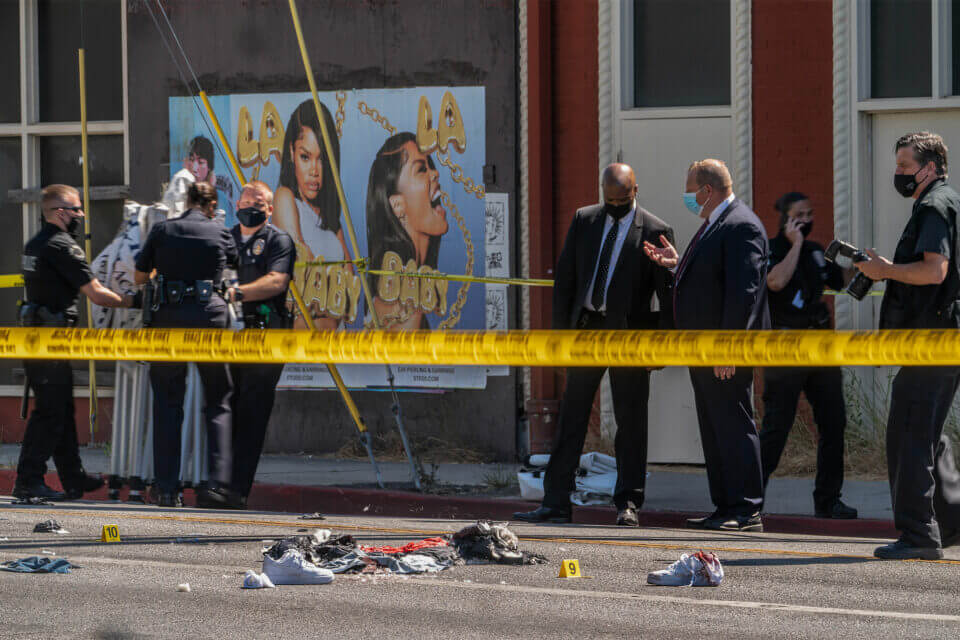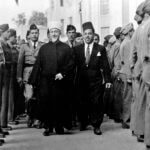
“There is a formula—unfortunately, I have noticed—when it comes to many in the reality-denying national press: Make a few accurate micro-points but use them to arrive at a conclusion that no reasonable person should believe.”
Editor’s note: The following is adapted from a speech delivered by the author at The Georgia Gang Investigators Association’s summer conference in Athens, Georgia on July 11, 2023. Also, this speech was delivered prior to the scandal involving Fulton County District Attorney Fani Willis.
In July of 2021, while I was still writing my weekly media criticism column, I published a short essay titled “When Covering Crime, an Underreported Piece of the Puzzle,” and this piece sought to explore the reality, as I see it, that the press, particularly the national press, habitually fails to convey to readers the degree to which gangs, especially in certain jurisdictions, account for a sizable portion of all crimes committed. Expanding on this initial premise, I further asserted that such awareness is also necessary to allow readers, who also double of course as voters, to understand better the pathologies that typically are associated with (or occur alongside) gangs, as well as to properly evaluate the various debates that intersect with discussions on gangs: from the reality that certain types of criminals might not be candidates for, in the parlance of the day, rehabilitation; to debates about the constitutionality or wisdom behind certain surveillance or policing practices; to the fact, as we have seen in places from Georgia to New York City to El Salvador (though that final location warrants a very separate discussion), that targeted gang crackdowns can be strikingly effective in reducing crime.
This piece “When Covering Crime, an Underreported Piece of the Puzzle,” along with the magazine I co-founded Merion West at various points featuring a number of op-eds and interviews with experts on gangs, is what I believe prompted my invitation to speak at this forum.
Now, this piece on gangs mirrored a couple of other media criticism columns I wrote during my time in that role in how it was structured. This piece was similar to another column I wrote in 2019 titled “Media’s Under-Coverage of Disease,” admittedly published before the Coronavirus (COVID-19) pandemic and the concomitant, nonstop coverage on the part of the press about that virus. However, in that article on how disease is typically covered, I discussed how news stories, including ones about what kill and most gravely harm us, widely miss the mark in terms of proportionality. News story after news story is trotted out day in and day out about various negative things, and many of these negative things are negative insofar as they discuss the loss of life. But the big culprits in terms of what actually kills people, from heart disease to cancer to road accidents and falls, are chronically under discussed in favor of coverage of other things. Remember that it is always curious to evaluate what the press chooses to focus on.
I noticed that a similar dynamic to the one I just described tends to exist when it comes to covering gangs. While admittedly local news tends, on the whole, to do a better job covering crime or at least instances of it, the national press, the media that most shapes our orientation to the world around us, tends to fall short when appreciating the extent to which gangs are responsible for dysfunction and violence in so many places in Georgia, in the United States, and around the world. Although the Department of Justice estimated in January of 2009 that approximately 80% of all crime in many communities is gang-related, an estimate roughly seconded by Georgia State Senator and Chairman of the Senate Committee on Public Safety John Albers in a February, 2023 hearing, if one were just reading The Washington Post, The Atlantic, The New Republic, and other blue-chip-type national news outlets, he would never know it.
Now, it barely warrants stating the obvious that the so-called mainstream media often falls short when it comes to adequately covering the country we live in. And even as greater and greater shares of Americans draw their news from other sources, whether favorite commentators who write sans editor on Substack to podcasters to those who have their own shows on Twitter spaces, it cannot be denied that the outlets such as those enumerated above still inform the consciousness of the nation at large, including perhaps most importantly by influencing thought leaders, as well as the producers and media executives who determine which coverage choices to make on television stations across the country, both national and local. As we say often in media criticism, the most significant bias in all of media lies in story selection.
In Georgia, of course, where this Governor, Attorney General, and leadership at the Georgia Bureau of Investigation and Georgia Gang Investigators Association have made combating gangs not only a priority but one that is openly and frequently discussed, public awareness of the issue may indeed be greater than in other places. But in many circles in other parts of this country such as where I live in suburban Pennsylvania, I typically receive dumbfounded looks when I bring up the fact that I write about and cover gangs. Gangs are often dismissed as if they are just a quaint particularly of a handful of neighborhoods on the West Coast or in Chicago or, worse yet, largely a fictional element of television shows or movies. When I tell these people, many of whom consider themselves reasonably politically informed and on top of current events, about the degree to which gangs are responsible for crime in many jurisdictions, they are perhaps too polite to say to my face that I am intentionally misleading them, but their countenances clearly betray that do not even come close to believing me.
Former Vice President Spiro Agnew, of all people, is famous for a key observation about the press when he remarked in 1969 that it, as the ultimate kingmaker, has the power to “elevate men from obscurity to national prominence within a week. [The news media] can reward some politicians with national exposure and ignore others.” We are all too familiar with how the media chooses to make certain issues or narratives a constant point of focus, and—in many cases—this can result in a seachange in public opinion bringing about significant changes to our society. In some cases, this can be positive, and in other cases it can be negative.
Reasonable people can, of course, disagree as to if the press has a positive duty to bring attention to certain issues or if the individual outlets that comprise what we collectively refer to as “the press” or “the media” only should act in the interest of profit and run whatever content brings the most clicks or views and, thus, the most dollars. However, we know, from experience—and, also, now with so many media projects from The Intercept to The Marshall Project expressly being non-profit ventures—that the press does choose to highlight certain issues regardless of the perceived profitability of doing so. So, with all of this mind, I am here—among other things—to make the case that the press, particularly the national press (the type I know best), has a duty, a responsibility, to bring into focus (and to do so in a compelling manner so that people actually listen and digest it) the importance of taking gangs seriously
Now, the first obstacle to all of this is that the press often wants us to disbelieve our own eyes. At Merion West, for instance, writers such as Alexander Zubatov have chronicled case after case where, statistics be damned, journalists have led us to conclusions that there is no evidence for or, worse yet, where the evidence points toward opposite conclusions, different conclusions, or no conclusion at all.
As such, unfortunately, when gangs are covered, in some cases, there appears to be an intentional effort to distort the reality of how they operate, the lives they harm, and the damage they inflict on the communities in which they operate. Unfortunately, many of the marquis publications trot out their respective don’t-believe-the-alarmists-on-gangs-type pieces.
In a March, 2018 New York Times op-ed, Alex S. Vitale, someone who would later be instrumental in endorsing the defund the police movement, wrote:
“The way the police and prosecutors are trying to dismantle youth gangs — haphazardly putting teenager’s names into gang databases, issuing civil injunctions, levying broad conspiracy charges and increasing deportations — is also a misguided panic that is likely to have the same effect [as erroneously pursuing the arrests of “juvenile superpredators.”] This kind of law enforcement relies on the same logic that has driven much of the enormous increase in incarceration over the last 40 years.”
He continued: “The use of large-scale conspiracy cases is also problematic. A few years ago, the New York Police Department began Operation Crew Cut, which involves long-term investigations of people suspected of being gang members in high-violence areas. Working with prosecutors, the department has conducted dozens of high-profile raids in which more than 2,000 young people have been arrested on state and federal conspiracy charges.
The Police Department believes that by targeting small groups of people responsible for much of the city’s gun violence, such raids have helped reduce the number of shootings over the past two years. Crime is down in targeted areas, but crime is also down across the city and the country. So it’s impossible to isolate the raids as the reasons for these declines.”
As we will discuss in greater detail shortly, and as we know well here in Georgia thanks to the efforts of “Operation Heat Wave” and findings from a study tracking the New York City Police Department’s preferred crime-fighting approaches, targeted gang crackdowns can be very effective at reducing crime.
But this piece, just as many others, is in the business of brushing away legitimate concerns about crime and gangs.
Chandra Bozelko, whose Washington Post author bio indicates that she is “a National Press Foundation fellow for reporting on criminal justice in the age of George Floyd” published a perhaps even more misleading piece in December of 2021 in The Washington Post’s “Outlook section” titled “Five myths about street gangs.” In the first alleged myth that Bozelko discusses, she actually takes aim at a local Georgia news story titled “Gangs, guns and drugs: College Park, South Fulton police target violent crimes in their communities” and asserts that it is, in reality, inaccurate to lump these three together before suggesting, as so many media critics do, that many discussions of gangs are cloaked in intolerable levels of racial bigotry.
This line of thinking has been seconded in other opinion pieces at The New York Times, as well as in outlets such as The Daily Beast, such as when Christopher Dickey, who passed away in 2020, argued in 2017 that former President Donald Trump and former Virginia gubernatorial candidate Ed Gillespie were entirely misguided in seeking to draw attention to MS-13 before arguing that this gang’s very existence in the United States can arguably be attributed to the threat of enforcing immigration laws by encouraging individuals who have immigrated here illegal to turn to gangs due to fears of law enforcement. While that may in some cases be technically and narrowly accurate, there is, of course, no proposal forwarded by Dickey to better control the flow of foreign nationals into the United States or more stringently enforce, at the federal level, immigration statues already in existence that could prevent some of the individuals who comprise these gangs from being in the United States in the first place. Heaven forbid a law enforcement solution was emphasized.
There is a formula—unfortunately, I have noticed—when it comes to many in the reality-denying national press: Make a few accurate micro-points but use them to arrive at a conclusion that no reasonable person should believe. That way the stories might still technically pass a fact-check while reaching conclusions that still make one scratch his head.
For many of these authors and opinion commentators in the national press, the central villain is the person or group of people seeking to tackle gangs, while those who are in them are dutifully acknowledged in passing as a problem before the article turns to attacking its primary target: those concerned about gangs and the danger they represent in communities. And, in the case of Vitale’s piece, of course, the very tactics that have been proven most effective at combating gangs are actively maligned. Many of the essays written by alleged experts on crime and the criminal justice system put forward conclusions that, as George Orwell famously put it, are so absurd “only intellectuals believe them.”
Now, it is true that these papers do, at times, cover gangs in their news sections matter-of-factly. For instance, a February, 2023 New York Times story was headlined: “U.S. Unseals Terrorism Charges Against Men Identified as MS-13 Leaders,” and, similarly, there was even a profile of Fulton County District Attorney Fani Willis that same month also in The New York Times, with considerable attention paid to her efforts to address the Atlanta area’s gang situation. (1)
However, as I would discuss time and again when writing my media criticism columns, when analyzing how a given issue is covered, it is essential to consider the degree to which it is spotlighted. As we know, the national papers, unlike their regional counterparts, are still thick, and buried somewhere in a back page one can find, if one looks for it, coverage on any number of issues of import. So, it is, in fact, being covered, but is it being emphasized? Is it being presented in a manner in which readers cannot help but take notice, exclaim, “Wow, I never thought about it like that or realized it was a problem to this degree,” share the link with their colleagues and family members, and, as they say, get conversations started. That is a concrete area where the press can improve: by not just mentioning gangs in passing but helping readers—and, at times, law enforcement officers, those working in district attorneys’ offices, political staffers, and the officeholders themselves—to understand why they should—indeed, why they must—care.
A point of comparison is on the coverage of the issue of fentanyl. We have all heard the word thrown around, and obviously those of us who work in law enforcement or cover crime and related issues closely know about it, but how does one make the general public stop and think through the degree of the issue? This was the subject of an event I was invited to attend in June of this year with the Republican presidential candidate Vivek Ramaswamy in Philadelphia. Philadelphia is, of course, home to the Kensington neighborhood, often cited by journalists and commentators as one of the most shining examples of urban decay, given its open-air drug market, though I will positively note that at the end of June, the Philadelphia Police Department made 175 arrests and seized more than $1.4 million in drugs and about 27 guns as the result of a “sweeping multi-agency effort.” However, in any case, Ramaswamy brought onstage a pair of mothers whose children were lost to the drug crisis and fentanyl in Philadelphia with the hope that the journalists there writing their stories would be able to find a way to make the problem stick. Sometimes a personal story is required to make an issue come to life. (2)
Other times, however, there might be a way to conceptualize better the statistics we often hear. On that latter point, I think of Congresswoman Madeleine Dean of Pennsylvania. While doing a one-on-one, “on the issues”-style interview with Merion West in 2019, she and one of our writers, Connor Mustakas, were discussing the issue of opioids. Seeming to sense the reality that often facts and figures go in a listener’s ear and out the other, Congresswoman Dean sought to make it stick, “In 2017, the year for which we have the most recent statistics, that number [of opioid deaths] increased to 72,000 people. It’s hard to get your head around 72,000 people [overdosing] in a year. Another way of looking at it, sadly and horrifically, is about 200 people a day. That’s like one airliner going down a day in this country—and I mean every day, 365 days a year.”
This is what the late Jimmy Callaway, the former president of the Georgia Gang Investigators Association, was similarly doing in a Merion West op-ed he wrote with us on New Year’s Day 2019 when, citing then-U.S. Attorney Bobby Christine, he remarked that there were more active gang members in Georgia alone than there were Islamic State combatants at that group’s height.
Similarly, in my aforementioned media criticism column “When Covering Crime, an Underreported Piece of the Puzzle,” I sought to do the same when helping readers wrap their heads around the figure put forward by the 2011 FBI estimate on active gang members in the United States, at 1.4 million. (I know that Mike Carlson, Fulton County’s Executive District Attorney, Major Crimes Division, asserted in a Merion West op-ed he wrote on gangs that this 1.4 million figure was a “lowball” estimate.) With that said, in my piece, I compared that number of 1.4 million to the population of Hawaii which also clocks in at 1.4 million and change. That is the sort of strategy, I think, that can get readers and those who follow the news to pay attention and say, “Wow, there are at least as many gang members in this country as there are people in a state in this country, and there are actually, in reality, far more because, as we know, gang members are hardly first in line to file their tax returns on turbotax every April or presenting themselves to be readily counted by the Bureau of Labor Statistics. So this is one way in which I think we can get people to start listening, but there have to be others.
And though, as an editor, I am extremely conscious of seeking to avoid undue sensationalism or pieces that traffic in gratuitous or voyeuristic outrage-based framing, something I have criticized at some length in my media criticism columns, perhaps, at times, coverage in the national press must bring into focus the reality of gang violence, whether by describing the stories of women and children targeted for human trafficking, young people led down a path of ruin, and lives ended far before their time. We also need explainer-type articles about gangs that are fair and accurate. Vox, perhaps the best known outlet in the genre of new media sites that bill themselves as explainer-type projects, is indeed willing to discuss gangs in Haiti and other parts of the world but has found every way possible to seek, perversely enough, to explain to readers how gangs in the United States do not, in fact, represent a significant problem, such as by claiming that “The Salvadoran-American gang MS-13 has become the face of the Trump administration’s favorite trope: the idea that people from other countries are sneaking into America and importing violence and crime” or asserting just last year that the case against “Young Thug and Gunna” is “built on decades of racist precedent.”
Other writers implore us to believe that there is no law enforcement solution to the problem, and the only viable path forward is to spend endless money more on enrichment programs and “anti-violence” social initiatives, even when so many dollars of these sort end up in the hands of politically-connected consultants and donors, such as was masterfully described by Sean Cooper at Tablet magazine in January of this year.
But there, nevertheless, remain opportunities for mainstream media sites from Axios to The Washington Post to local-news-centered new media projects such as 6AMCity to make clear what gangs do, whom they impact, what can be done to combat them, and, if dollars and cents are indeed the focus, how their presence undermines investment and economic development. One area of focus that I have always thought is worthy of further media exploration is to compare and contrast many of the gangs of today not only from one another but from the Italian mafia, something Carlson has done in some of his writings and a topic I discussed with Georgia Attorney General Chris Carr when interviewing him in Atlanta in August of 2019. Given that so many Americans are familiar with the rough idea of the Italian mafia, whether from television series such as The Sopranos, Selwyn Raab’s 2005 book Five Families, and for people like myself who grew up in the Northeast watching the erstwhile frequent news coverage of organized crime in that region, explaining how the gangs of today are different can perhaps help people better understand. Unlike the Italian mafia, which tended in many cases to regard violence as an undesirable intrusion into maximizing the bottom line, certain gangs of today relish in the opportunity to inflict gratuitous pain on those who are not part of the criminal enterprise. As Carlson has indicated, many of the gangs of today thrive on “Hyperviolent exhibits of force in public.” How about more reporting on that…
However, as some commentators on gangs have reasonably speculated, perhaps obscuring the extent of the truth is intentional on the part of the press because if the general public, in many cases, knew the extent of the problem, they would be panic-stricken.
On the bright side, however, given the proliferation of what I have been referring to as “new media” projects, there are ever more sources springing up, many of which might indeed be led by journalists and editors who are indeed interested in addressing crime. For every Marshall Project that is unabashedly, as they say, pro-defense, there is Law Enforcement Today, RealClearPolitics, the YouTube Channel Soft White Underbelly, which has some powerful segments on gangs, including interviews with former gang members, and writers on Substack who actively seek to take seriously public safety, no matter which sacred cows must be slain in order to speak candidly and honestly about it. And then there are individual writers such as Heather Mac Donald, the author of the 2016 book The War on Cops and someone who has written insightfully about “the Ferguson Effect,” and she, for instance, has been eager to join me for a number of discussions at both Thinkspot and Merion West about issues such as these related to violent crime. For those of us who are in a position in departments looking to make contact with the press, I recommend looking at writers at outlets such as City Journal and RealClearPolitics who have shown a willingness to discuss crime honestly and share your stories with them. (For instance, I appreciated Rafael A. Mangual’s December, 2019 City Journal piece “A Serious Threat to New York.”)
I recognize that the relationship between the press and law enforcement and, furthermore, many political officeholders can be fraught, particularly in recent years. We are familiar with how many journalists, particularly of the national variety, can be found daily on Twitter, the place where they are most inclined to congregate, making excuses for activists who are explicitly anti-police and secondly going to great lengths trying to explain how District Attorneys just as Larry Krasner in Philadelphia, who have overseen their cities’ homicide rates climb back to all-time highs from the early 1990s, are actually doing a good job. Again, they are making us disbelieve our own eyes.
Then, there is the reflexive opposition to certain proposals from certain political figures even if indeed they are correct and an about-face should a near-identical proposal be put forward by a political candidate who is more preferred. So when Charly Lyda challenged me recently to propose perhaps a bullet-point list of concrete ways agencies might be able to communicate better with the press, I indicated to him my belief that so much of this is relationship-based, thus making it more difficult to generalize. But the positive in this is that when one finds a journalist whom one trusts, whether in the national press, in the local news here in Georgia, or an independent podcaster or Substack writer, he can build on that: share with this person what is most important, including some of the crystalizing presentations of statistics or personal stories I have alluded to above. Just as we talk about certain types of policing that are best done through relationships with people in the community, journalism can be much of the same, so when a dedicated journalist and a committed individual within or adjacent to law enforcement collaborate, we might achieve the overall objective I outlined at the beginning of my remarks: increasing the average knowledge about gangs among readers and voters so that they might demand action. This might include, for instance, residents of other states demanding anti-gang laws similar to Georgia’s or calling for the passage of a strong federal anti-gang statute. (And we must do this while taking into account legitimate concerns about how these laws might be written. They ought not be unnecessarily broad or encroach too significantly on civil liberties.)
As many in Silicon Valley will tell you, often begrudgingly, when it comes to which early-stage ventures receive funding and which are left to dry up, it is narrative that wins the day. So just as the media led most Americans to believe that far more unarmed black men are killed by the police than, imagine if the press did their job on gangs. (To that point, according to a 2021 study titled “How Informed are Americans about Race and Policing?,” over half (53.5%) of those self-reporting as having “very liberal” political views estimated that 1,000 or more unarmed Black men were killed in police-involved shootings in the United States, when, in reality, the number for that year was 13-27.) I am not one to argue it is the job of an ideally objective and unbiased cadre of news reporters to paint narratives—that is more the domain of commentators, authors, and people like those gathered here today. But if the press, especially at the national level, simply called it as it was, I doubt it would be difficult to create a much-needed national narrative that gangs (and, for that matter, crime in general) represent an urgent problem. And perhaps even more importantly, by citing evidence, such as the WSBTV.com News Staff did in July of last year in their piece “Atlanta police say new approach to targeting gangs is getting results,” the press can emphasize that gangs can indeed be dismantled, resulting in lowered rates of crime in the communities where takedowns occur. Similarly, The Atlanta Journal-Constitution (AJC) and Fox 5 Atlanta have successfully brought into focus how Operation Heatwave—and its focus on gangs, guns, and drugs—has resulted in dramatically reduced rates of crime or how since Young Thug was arrested, it is estimated that crime in the area has fallen significantly.
These outcomes are in line with results reported by Aaron Chalfin, Michael LaForest, Jacob Kaplan in their 2021 paper “Can Precision Policing Reduce Gun Violence? Evidence from ‘Gang Takedowns’ in New York City,” which studied “New York City’s campaign of ‘gang takedowns,’ in which suspected members of criminal gangs were arrested in highly coordinated raids and prosecuted on conspiracy charges. As the authors write, “We show that gun violence in and around public housing communities fell by approximately one third in the first year after a gang takedown. Our estimates imply that gang takedowns explain nearly one quarter of the decline in gun violence in New York City’s public housing communities over the last eight years.” These findings fortunately were covered by Tucker Carlson on his Fox News show Tucker Carlson Tonight. And though Carlson is, of course, no longer at Fox News, on the subject of that network, I will positively note that Laura Ingraham fortunately took time in an April, 2023 broadcast of The Ingraham Angle to discuss gangs: “A free-for-all, and permissive attitudes toward crime in liberal enclaves? That’s a given. The incentive to use younger kids to commit some of the worst acts of violence. That’s new. The gangs are also getting more sophisticated in their recruiting, even using social media disguising themselves as public interest organizations. So in a nation facing recession, criminal gangs are now a growth industry.”
As I was suggesting when discussing the reporting on Operation Heat Wave, this is an important place to make clear, if I have not done so sufficiently already, that there are many bright spots in coverage as of late on the part of the Atlanta-area press when it comes to gangs and crime, including reporting—at times—by George Chidi, Mark Winne, and Richard Fausset of The New York Times. I also appreciated Christian Boone’s November, 2018 AJC piece “New alliances, social media stardom fuel growth of Atlanta gangs,” which opens with the lines: “First, you get the money, celluloid gangster Tony Montana memorably advised. Then, you get the power. Today, 1 million Instagram followers will get you both.” (It is crucial on this point to draw attention to—as a seminar I sat in on here yesterday did—the intersection of popular culture and social media with gangs.) I can only hope that more of this will be emulated by media outlets in other parts of the country, where combating gangs is not—as of this moment—as high of a priority on the part of political leaders there.
And, in addition to covering better what gangs are, how to identify up to a point the various ones, a more comprehensive coverage of gangs on the part of the press might also reasonably delve into related topics such as balancing surveillance tactics, including gang databases, with reasonable Fourth Amendment concerns; the potential for facial recognition to come at the cost of privacy; and though they are sometimes too frequently suggested as a panacea by overly pro-defense members of the press, the role of education and after-school programs for young people to try to prevent their joining gangs in the first place.
But when according to reporting by NBC4 Washington that 67% of Washington, D.C. arrests were not prosecuted in 2022, Larry Krasner being decidedly re-elected as District Attorney of Philadelphia in 2021, Los Angeles County, in May, doubling down on its no bail policy for certain offenses, a move recently and notably condemned by rapper 50 Cent, and far too many otherwise reasonable people not yet waking up and realizing “defund the police” was as absurd as it was when I first decried it in a Hill op-ed on June 3, 2020, as cities first began to burn, perhaps the job of the press is bigger than I have even considered in my remarks today when it comes to the sea change clearly required in how the American public is relating to crime, particularly in certain states and cities.
As I approach the conclusion of my remarks, I will note that it is well known that certain officeholders across the country have, at times, been reluctant to talk about their respective gang problems because by admitting there was a problem, they feared—and feared reasonably—that voters might blame them for letting the problem get so out of hand. But we know that problems fester when unattended to, and this can take the form of economic decline through would-be entrepreneurs declining to open businesses in these areas to other businesses packing up and leaving to declines in net migration into a community. When that happens, they are often finally forced to blow the proverbial whistle. But whether or not a given politician is willing to speak openly about the degree to which gangs are a problem before that point, it is the job of the press to bring attention to it all. We must hold these individuals accountable. And this cannot be simply a self-congratulatory tagline on the part of the press. It must become the ever-present, resolute reality.
By doing this, we might be able to address perhaps the central problem I have described throughout my remarks today: the disconnect between the degree to which gangs are a problem in the United States, particularly in certain pockets of it, and the reality that so many Americans, especially those who live in places other than those pockets, fail to appreciate (or are unaware of) their danger, as well as the fact that there are methodologies and techniques that can be used to hobble them.
When I used to write at the opinion section of The News & Observer in Raleigh, North Carolina, there was a change in guiding philosophy beginning in 2018 when John Drescher became executive editor of the newspaper. Acknowledging that so much commentary amounts to little more than hand-wringing or, as I phrased in a 2015 Orlando Sentinel op-ed, “criticizing the status quo without proposing solutions,” Drescher wanted the opinion section at his paper to be more focused on solutions rather than just endlessly bemoaning how things are. As such, I will close with a few recommendations of what the press, generally speaking, can improve upon when covering gangs and, for that matter, crime in general.
First and foremost and as I have hopefully successfully argued throughout my remarks today, in addition to chronicling better what gangs do and what they are like, the press can emphasize that there are indeed law enforcement solutions.
Second, news outlets can run op-eds by those calling out gangs and the harm they cause, like the AJC did in June of 2021 with Attorney General Chris Carr’s op-ed “We can’t tolerate gang criminals terrorizing Georgians.”
Next, this is, for better or worse, the age of infographics, and from FiveThirtyEight on down, we have learned that presentations of data can be as important as the underlying data itself. So, just as The Washington Post did with police-related shootings though far too few, as we know, have sufficiently engaged with what that data says, I suggest, though there are logistical challenges, to have a database of gang-related prosecutions in various jurisdictions, as well as helpful map-based infographics about different gangs and where they tend to operate, as well as their characteristics. Unlike some of the websites that have been maintained in the past that have attempted roughly to do this, it should be interactive, user-friendly, and poignant–and updated consistently.
Also, as George F. Will put it while endorsing the push for congressional term limits by acknowledging “while we are recommending the inconceivable,” imagine if the marquis national media outlets had a designated journalist for gangs like they do for many fashionable left-of-center causes. Imagine how that would impact public perception of gangs across the nation and fuel urgent calls for action.
And, lastly, as I mentioned before, so much of this is about personal relationships, so if one is in the position in his or her department or organization to be in communication with the press, if one has a strong relationship with a journalist also invested in tackling the gang issue, nurture that, cultivate it, follow up when he does not respond because his inbox is flooded, and build that relationship over the years.
Shortly after her husband assumed the office of President of the United States following the death of President John F. Kennedy, First Lady Lady Bird Johnson, like many First Ladies, chose a cause to champion. In her case, as many of us have heard about previously, it was littering. From emphasizing the beautification of highways, which culminated in the passage of the Highway Beautification Act in 1965, to imploring Americans not to litter, the efforts of Lady Bird and others resulted in a dramatic shift in how Americans viewed littering: from something one would hardly think twice about doing in many cases to it becoming almost unthinkable to most of us. Much the same has taken place also with public campaigns about health-related issues such as tobacco use and seat belt usage. So what I am calling for is a similar sea change in how the American public relates to and thinks about gangs: that their continued existence on a large scale is completely unacceptable and must be urgently addressed. It is incumbent on all of us to work to make that a reality, and the press must be a reliable, steadfast part of that effort.
Erich J. Prince is a co-founder of Merion West.
Endnotes
- Although I sincerely appreciate District Attorney Willis’s efforts to combat gang crime, I join those strongly critical of her case against former President Donald Trump. This also invites further consideration of how RICO statutes can be abused or misapplied.
- At the same time, though, and as I have described in the past, relying disproportionately on the testimonies of those most personally affected by a given crisis can have its share of downsides as well.











